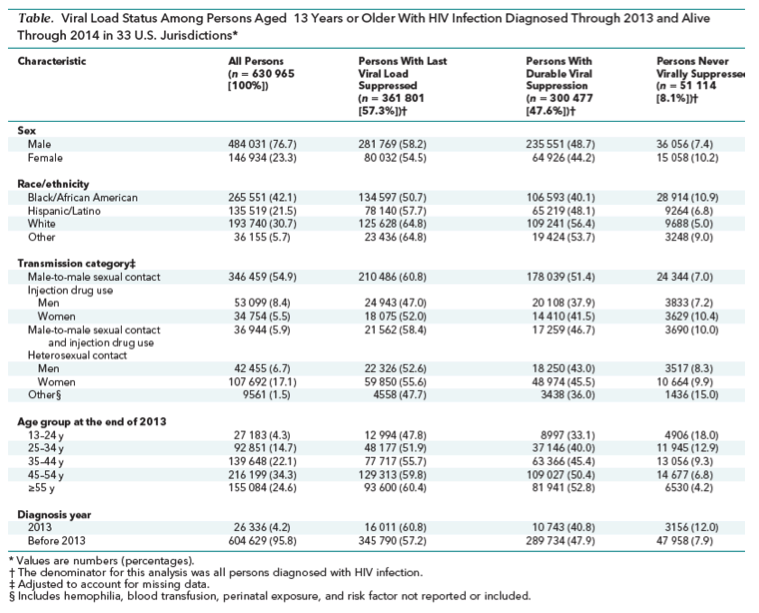 |
 |
 |
| |
CDC Reports 57% Viral Suppression Rates
|
| |
| |
Viral Suppression Patterns Among Persons in the United States With Diagnosed HIV Infection in 2014 - CDC
"Of all persons with HIV infection, 57.3% had a suppressed viral load on their most recent test in 2014, a total of 47.6% had durable viral suppression throughout 2014, and 8.1% never achieved viral suppression during 2014 (Table). Those more likely not to have viral suppression on their most recent viral load test or durable viral suppression were women, black persons/African Americans, younger persons, and persons with HIV infection from causes other than male-to-male sexual contact. The 51 114 persons who never achieved viral suppression in 2014 had an average of 17 530 copy-years of viremia; of these, 28 765 (56.3%) had at least 2 tests for viral load in 2014, which indicates that they probably received regular care for their infection. These persons had an average of 21 387 copy-years of viremia."
"we calculated 3 longitudinal measures: the percentage of persons in whom all viral loads in 2014 were less than 200 copies/mL (durable viral suppression) and 200 copies/mL or greater (viral suppression never achieved) (3) and a measure of viremia known known as the "copy-year." Copy-yearsmeasure a person's exposure to HIV over time the way that pack-years measure a person's exposure to tobacco smoke over time. For example, 10 000 copy-years could indicate that a person had 1000 copies of the virus every day for 10 years, 10 000 copies every day for 1 year, or 5000 copies every day for the first half of the year and 15 000 copies every day for the second half (4). We used the geometric mean to calculate viremia over time."
Annals of Medicine 2017

Background: The most common measure of HIV suppression in clinical and surveillance studies is whether a patient's most recent viral load was less than 200 copies/mL during the preceding 12 months. This single-value measure provides only a snapshot of suppression status and does not capture changes in viral load over time (1, 2). Persons who are suppressed according to their most recent viral load measurement may still transmit HIV if their suppression status changes.
Objective: To determine the usefulness of a single measure of viral load for understanding long-term suppression and examine the extent of cumulative HIV burden for understanding the potential risk for transmission.
Methods and Findings: We used data reported to the National HIV Surveillance System through June 2016 from 33 jurisdictions with complete reporting of tests for CD4+ cell count and viral load. We included persons aged 13 years or older who were diagnosed with HIV infection through 2013, most recently resided in 1 of the 33 jurisdictions, and were alive through 2014. We used information about sex, age, transmission category, and race/ethnicity (2) to calculate the percentage of persons with HIV infection whose last viral load in 2014 was less than 200 copies/mL. In addition, we calculated 3 longitudinal measures: the percentage of persons in whom all viral loads in 2014 were less than 200 copies/mL (durable viral suppression) and 200 copies/mL or greater (viral suppression never achieved) (3) and a measure of viremia known known as the "copy-year."
Copy-yearsmeasure a person's exposure to HIV over time the way that pack-years measure a person's exposure to tobacco smoke over time. For example, 10 000 copy-years could indicate that a person had 1000 copies of the virus every day for 10 years, 10 000 copies every day for 1 year, or 5000 copies every day for the first half of the year and 15 000 copies every day for the second half (4). We used the geometric mean to calculate viremia over time.
A total of 630 965 persons were diagnosed with HIV infection through 2013, with 4.2% of infections diagnosed that year. The median time between diagnosis and the end of 2013 was 11 years (interquartile range, 5 to 17 years), and viral load was measured a median of 2 times in 2014. Of all persons with HIV infection, 57.3% had a suppressed viral load on their most recent test in 2014, a total of 47.6% had durable viral suppression throughout 2014, and 8.1% never achieved viral suppression during 2014 (Table). Those more likely not to have viral suppression on their most recent viral load test or durable viral suppression were women, black persons/African Americans, younger persons, and persons with HIV infection from causes other than male-to-male sexual contact. The 51 114 persons who never achieved viral suppression in 2014 had an average of 17 530 copy-years of viremia; of these, 28 765 (56.3%) had at least 2 tests for viral load in 2014, which indicates that they probably received regular care for their infection. These persons had an average of 21 387 copy-years of viremia.
Discussion: Our results confirm those of other studies (1, 2). Single measures of viral load overestimate how many persons with HIV infection have durable viral suppression (20% relative difference). In addition, some persons who seem to have received regular care for HIV infection in 2014 still had viral loads high enough to substantially increase transmission (>10 000 copies/mL) (5). These findings emphasize the importance of routine monitoring of viral suppression status and of more effective delivery of appropriate therapy in response to the results of such monitoring (5).
|
| |
|
 |
 |
|
|